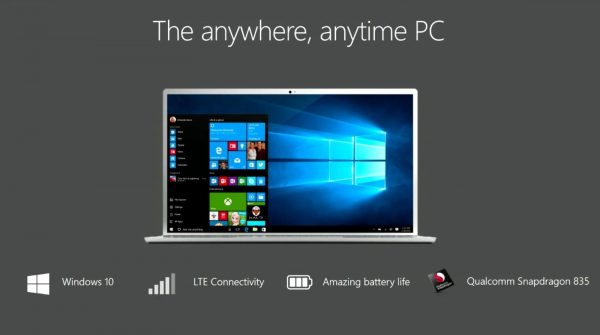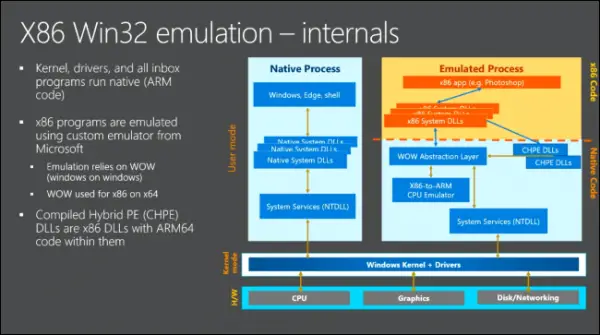Microsoft earlier bought Windows operating system to ARM-based devices with Windows RT for x32 ARM Processors. Windows RT was first announced at CES 2011 and was released as a mobile operating system along with Windows 8 in October 2012. It was designed to come preinstalled with hardware from specific OEMs. Microsoft’s first Surface Tablet had an ARM-based processor made by NVIDIA, and it ran Windows RT as well. There were many other devices from other Microsoft partner OEMs like Dell and HP that were shipped with Windows RT and an ARM Processor. But now Microsoft is returning to the game with Windows 10 on ARM.

What was Windows RT
Windows RT was another flavor of Windows 8 released along with it designed specifically for low powered devices. As mentioned above, these low powered devices came with ARM processors like the Qualcomm’s Snapdragon 800 or ARM chipsets made by makers like NVIDIA (Surface).
This gradually decreased the cost of these new devices, and at the same time, you get great battery life. But you lose some things too. You cannot run any apps that didn’t come out of the box. But there are exceptions, like Microsoft Office that was optimized to run on Windows RT. But other than that, you could mainly run Windows Store apps only which made it immune to Viruses and Malware.
What is Windows 10 on ARM
At WinHEC 2016, Microsoft’s Terry Myerson demoed Windows 10 running on a Qualcomm Snapdragon 835 flagship chipset. People might say that this was nothing but a Windows 10 flavor of Windows RT, but it isn’t. Microsoft took the game a little forward. Windows 10 on ARM initiative was to bring desktop-like experiences to low-powered and cheaper devices. And by desktop-like experience, they mean that users can now run Win32 applications like full Adobe Photoshop on those devices. However, the speed and reliability won’t be better than conventional Intel CPUs, but these cheap devices will just get your work done.
Also, with Windows 10 on ARM, users will now be able to take advantage of LTE Connectivity. They will be able to buy a plan for their devices and stay connected to the Internet even on the go.
Read: How is Windows on ARM different from Windows RT.
Why is Windows 10 on ARM good for Microsoft
The desktop CPUs that Intel or AMD makes are based on x86 and x64 architecture. But mobile devices like iPhone, or other Android or Windows Phones used a CPU based on the ARM Architecture.
These ARM chips are cheap, portable, have greater connectivity capabilities with LTE and better battery life unlike the conventional chips from Intel and AMD.
So, with Windows 10 on ARM and support from its partners, Microsoft aims to make Windows 10 devices more affordable for consumers. They strive to bring 2-in-1 devices like Surface or Laptops but with ARM processors and hence Windows 10 on ARM.
What are the advantages of Windows 10 on ARM
As per the statement by Microsoft, these are the advantages of Windows 10 on ARM.
This new Always Connected PC is ultrathin, beautifully designed, running Windows 10 and a new, optimized version of Office 365. But beyond the full experiences you’d expect in a PC, this new Always Connected PC has fundamentally transformed how I work, because of three significant advantages over my other PCs.
- The screen is instantly on whenever I pick up the device. I never have to wait for it to wake up, it’s just on.
- Being always connected wherever I am whether I am in the car, airport or coffee shop, always being connected just feels like the most natural, safe and secure way to work with teams and be creative.
- Lastly, the battery life is just awesome! I am finding myself charging it once a week. When I was using a wearable that needed to charge every day, I didn’t really rely on it. Once I moved to a Fitbit that only needed charging once a week that was game changing for me. Not carrying around power cords is liberating.
How does it run x86 apps when it is made for ARM

All the things that I will be briefly described now will be coming from this video from a session about Windows 10 on ARM from Build 2017.
Now, these x86 apps run by using an emulation layer. This layer of emulation works magically to make it all up. The code for Kernal, drives and other inbox programs like Microsoft Edge, Microsoft Store, Calculator, Camera and other pre-loaded apps are written for ARM. The other x86 apps like Adobe Photoshop or 7-zip are executed using custom emulator from Microsoft called WOW or Windows on Windows. And for the x86 DLLs, Compiled Hybrid PE or CHPE is used to convert the code in x86 to ARM64. This makes all the magic to happen.
I use Win 10 laptop when at home — and I only take one device when I go out (which is my Android phone). I see no reason to carry more than one device for my needs. So Windows on ARM doesn’t interest me at all.
BUT, if MS can come up with a convincing Windows phone…
Windows phone is officially dead – don’t wait for it.